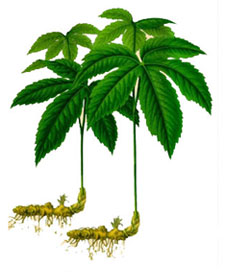Goldenseal
 Overview
Overview
Goldenseal is a small plant which is a perennial and is a member of the buttercup family. It has an erect, hairy stem, with the stem emerging from a rhizome that is usually not more than 2 inches long and ¾ inch thick. The plant is fleshy in texture and marked with scars from earlier years which are shaped like seals. The rhizome is knotted and twisted and is covered with yellow-brown bark and is yellow inside. While this plant was formerly quite common in the eastern U.S. and Canada, it has seriously diminished in numbers and is now considered an endangered species.
Goldenseal is commonly used to treat infections and inflammations of the mucous membranes of the digestive tract, upper respiratory tract and the genitourinary tract.
History of Goldenseal
This herb is often associated with the American Indians. Goldenseal kept the Cherokee Indians from being thought of as red men because they stained their faces and their clothes with the juice from this root.
The Cherokees also were known to mix powdered goldenseal root with bear grease and used this compound as a bug repellent. The Indians thought so highly of goldenseal that they saved enough of the plant to cure almost every affliction known to mankind.
The American pioneers used goldenseal to treat wounds, rashes and watering eyes. The plant was also chewed to relieve mouth sores. Goldenseal became an herb which was attributed to have almost magical powers. The American herbalist Jethro Kloss called it “one of the most wonderful remedies in the entire herb kingdom,” calling it a “real cure-all.”
In the early 1900s this herb was so popular the U.S. Department of Agriculture even published flyers outlining how to cultivate goldenseal so it would not become extinct from over cultivation. To this day, goldenseal remains scarce, making it a pricey commodity to purchase.
Goldenseal Constituents
The constituents in goldenseal which give it therapeutic and preventative effects include:
- Alkaloids – Isoquinoline alkaloids including berberine, hydrastine and canadine
- Miscellaneous - Meconin, chlorogenic acid, saturated and unsaturated fatty acids, and carbohydrates including D-fructose, D-galactose and sucrose
Goldenseal Health Benefits
The most active ingredient in goldenseal is called hydrastine. This compound is said to be the cause behind any healthy medicinal effects goldenseal may have on the human body.
Eyewash made with goldenseal is known to be mildly antibiotic, in particular against Staphylococcus aureus. It is also an astringent and can reduce inflammation. This astringent action also makes it a good treatment for menorrhagia and post-partum hemorrhage.
Goldenseal extracts also seem to lower blood sugar levels, which could make them useful for alleviating anxiety and stress.
This herb is also used to treat the common cold. It can be used alone or in combination with Echinacea. Berberine sulfate has been known in research studies to prevent the adherence of streptococci to host cells, which could explain in part its antibiotic properties. Many people who practice alternative medicine begin taking goldenseal capsules at the first sign of a cold or flu, as well as for other infections.
Another study showed that a single dose of berberine sulfate at 400 mg was shown to decrease the mean stool volume and duration of diarrhea when given to adults who were suffering from acute diarrhea due to Escherichia coli. Goldenseal is also known to be an anti-parasitic.
Berberine sulfate has also been known to inhibit tumor-promoting actions of some cancers.
When used externally, goldenseal can help to treat skin conditions such as eczema, athlete’s foot, ringworm, impetigo and pruritis.
One interesting note regarding goldenseal is that it shows a major jump in effectiveness when the pH of body fluids increases. If the gastrointestinal tract is quite alkaline with a pH of 7, goldenseal is up to four times more effective than when the pH is just 1 step lower (or more acidic) at a level of 6.
Dosage
The following are the generally recommended dosages for goldenseal:
- Liquid extract – 0.3 to 1 ml three times daily
- Solid extract – 250 mg three times daily
- Dried root and rhizome – 0.5 to 1 g dry or as a decoction, three times daily
- Hydroalcoholic tincture – 2 to 4 ml three times daily
- Standardized extract – 250 to 500 mg three times daily
Adverse Effects
In large doses, goldenseal’s major component, hydrastine, is considered to be toxic and dangerous. Eating this plant while it is fresh could ulcerate and inflame the mucous membranes in the mouth. Of particular concern is the fact that hydrastine remains in the system for a long period of time and accumulates in the body.
Large quantities of goldenseal in the body will over stimulate the nervous system and can cause convulsions, miscarriage, respiratory failure, and the overproduction of white blood cells. Some symptoms of toxic reactions include nausea, vomiting, diarrhea and a bunting skin sensation.
Goldenseal has no known drug interactions.
References
- Bone, K. A Clinical Guide to Blending Liquid Herbs: Herbal Formulations for the Individual Patient, Churchill Livingstone (2003)
- Braun, L. & Cohen, M. Herbs & Natural Supplements: An evidence-based guide, Elsevier (2005)
- Duke, J. The Green Pharmacy: Herbal remedies for common diseases and conditions from the world's foremost authority on healing herbs, Rodale Limited (2003)
- Kowalchik, C. & Hylton, W. Rodale's Illustrated Encyclopedia of Herbs, Schwartz Books (1987)
Posted in Goldenseal
Ask a Question Or Join a Discussion


